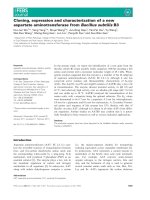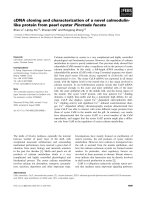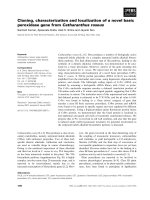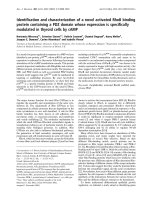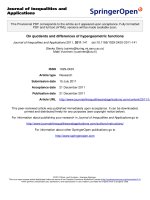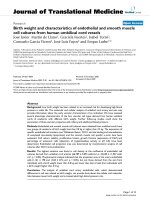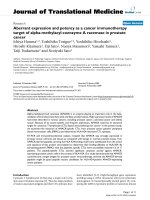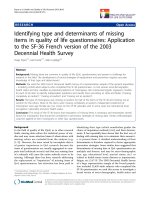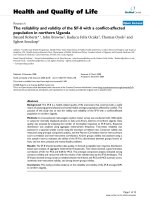báo cáo hóa học: "Initial development and testing of a novel foam-based pressure sensor for wearable sensing" doc
Bạn đang xem bản rút gọn của tài liệu. Xem và tải ngay bản đầy đủ của tài liệu tại đây (517.06 KB, 7 trang )
BioMed Central
Page 1 of 7
(page number not for citation purposes)
Journal of NeuroEngineering and
Rehabilitation
Open Access
Research
Initial development and testing of a novel foam-based pressure
sensor for wearable sensing
Lucy E Dunne*
1
, Sarah Brady
2
, Barry Smyth
1
and Dermot Diamond
2
Address:
1
Adaptive Information Cluster, Department of Computer Science, University College Dublin, Belfield, Dublin 4, Ireland and
2
Adaptive
Information Cluster, National Centre for Sensor Research, Dublin City University, Dublin 9, Ireland
Email: Lucy E Dunne* - ; Sarah Brady - ; Barry Smyth - ;
Dermot Diamond -
* Corresponding author
Abstract
Background: This paper provides an overview of initial research conducted in the development
of pressure-sensitive foam and its application in wearable sensing. The foam sensor is composed of
polypyrrole-coated polyurethane foam, which exhibits a piezo-resistive reaction when exposed to
electrical current. The use of this polymer-coated foam is attractive for wearable sensing due to
the sensor's retention of desirable mechanical properties similar to those exhibited by textile
structures.
Methods: The development of the foam sensor is described, as well as the development of a
prototype sensing garment with sensors in several areas on the torso to measure breathing,
shoulder movement, neck movement, and scapula pressure. Sensor properties were characterized,
and data from pilot tests was examined visually.
Results: The foam exhibits a positive linear conductance response to increased pressure. Torso
tests show that it responds in a predictable and measurable manner to breathing, shoulder
movement, neck movement, and scapula pressure.
Conclusion: The polypyrrole foam shows considerable promise as a sensor for medical, wearable,
and ubiquitous computing applications. Further investigation of the foam's consistency of response,
durability over time, and specificity of response is necessary.
Background
We live in a world of information, and emerging technol-
ogies compel us to look for new ways to collect, process,
and distribute information. Today we are faced with a sig-
nificant information overload problem as users struggle to
locate the right information in the right way at the right
time. In response, a number of researchers have suggested
that adaptive information technologies may hold the key
to the next generation of ubiquitous information systems,
systems that automatically adapt to changes in their envi-
ronment and usage in order to deliver users a more intel-
ligent, proactive and personalized information service. In
this paper we provide an overview of initial research con-
ducted as part of the Adaptive Information Cluster http://
www.adaptiveinformation.net a multi-disciplinary
research cluster that brings together researchers in areas
such as wearable computing, sensor technologies, infor-
mation retrieval and artificial intelligence with a view to
developing the next generation of intelligent, sensor-
based wearable computing technologies.
Published: 01 March 2005
Journal of NeuroEngineering and Rehabilitation 2005, 2:4 doi:10.1186/1743-0003-2-4
Received: 06 January 2005
Accepted: 01 March 2005
This article is available from: />© 2005 Dunne et al; licensee BioMed Central Ltd.
This is an Open Access article distributed under the terms of the Creative Commons Attribution License ( />),
which permits unrestricted use, distribution, and reproduction in any medium, provided the original work is properly cited.
Journal of NeuroEngineering and Rehabilitation 2005, 2:4 />Page 2 of 7
(page number not for citation purposes)
Sensing in the wearable environment is crucial for many
applications, but existing sensor technologies pose signif-
icant wearability problems when integrated into the user's
peri-personal space. One of the most compelling needs
for wearable technology is in the continuous monitoring
of the human body, be that for medical monitoring or to
inform the operation of a context-aware computerized
application. While many technologies that are often made
wearable (such as music players or telephones) function
nearly as well (or sometimes better) as portable devices,
almost all continuous body-sensing technologies must be
worn to be effective. However, because of their ubiqui-
tous, constant-wear nature, such technologies must prior-
itise the effects of the technology on the user's physical
comfort as well as social comfort. Traditional sensing
technologies are rarely designed for continuous, on-body
use: those that require skin contact are generally designed
to be used in a hospital or doctor's office, and those that
do not are generally designed for use in stationary devices.
Consequently, the achievement of certain design goals for
existing sensors (such as durability) is ultimately detri-
mental to the user's comfort when applied to the wearable
environment. For example, durability often equals stiff-
ness, which results in a solid device that can cause discom-
fort by localizing pressure.
Textile-based sensors offer a compromise solution to this
problem, by retaining the characteristics associated with
comfort and wearability (properties of standard, non-elec-
tronic garments). Many textile-based sensors are actually
sensing materials used to coat a textile [1] or sensing mate-
rials formed into fibres and woven or knitted into a textile
structure [2]. The properties sought by textile-based sen-
sors can include flexibility, surface area, washability,
stretch, and hand (texture of textile). However, they must
also include the properties required for the electronic
device, including durability, power consumption, and
ease of connection into a circuit. Metallic components,
designed to function in rigid environments, often do not
satisfy these needs. For instance, a metallic element in a
high-flex environment (such as a garment) will soon
break. However the recently discovered [3] conducting
electroactive polymers (CEP), offer a potential solution to
this problem. CEPs such as polypyrrole (PPy), polyaniline
and polythiophene constitute a class of polymeric materi-
als which are inherently able to conduct charge through
their polymeric structure. They can be reversibly switched
from the doped conducting state to the undoped insulat-
ing state upon chemical or electrochemical treatment. In
particular, polypyrrole has attracted much interest
because it is easily prepared as films, powders and com-
posites, has a relatively high conductivity and is relatively
stable in the conducting state. However, when the black
precipitate of PPy has been formed it is insoluble to all
known solvents and is non-processable. To overcome this
PPy can be simultaneously polymerised and deposited
onto the substrate [3]. The result is that the substrate is
covered with a thin layer of PPy rendering the whole
object conducting without compromising the mechanical
properties of the substrate.
Methods
Sensor Development
In previous work [4], a novel polymer synthesis method-
ology was developed to create a textile-like structure capa-
ble of sensing changes in planar or perpendicular
pressure, by coating an open-cell polyurethane (PU) foam
with a CEP (polypyrrole). The method used for sensor
fabrication is described in [4]. The method involved soak-
ing the substrate, the PU foam in an aqueous monomer
and dopant solution. An aqueous oxidant solution was
then introduced into the reaction vessel to initiate polym-
erisation. This lead to the precipitation of doped PPy,
which subsequently deposited onto the PU substrate.
Sensor Characterization
Characterisation for the PPy-coated PU foam was carried
out using a number of methods as described in [4]. It was
found that increasing the weight placed upon the PPy-PU
foam or shortening the overall length of the foam resulted
in a proportional decrease in the electrical resistance
measured across the foam in a linear fashion. Results from
tests carried out using the Instron™ tensile testing instru-
ment, courtesy of the University of Bath, England, showed
that the stress-strain profile of the unadulterated PU foam
sample and that of the PPy-coated PU foams sample were
similar showing regions of elastic and inelastic responses
to force. Problems such as repeatability and long-term
aging of the foam were identified. The issue of repeatabil-
ity was due to hysteresis effects observed during the tensile
testing of the foam. These effects were observed for the
coated and uncoated samples thus originating from the
PU substrate. The effect of the PPy coating was to make the
entire foam conducting without compromising the soft,
compressible mechanical properties of the foam
substrate.
Torso Garment
Once a predictable reaction was observed from the foam,
it was applied to the wearable environment to explore its
utility in garment systems. It was integrated into a torso
garment in several ways to investigate the ability of the
foam sensor to monitor specific body changes and physi-
ological signals. The test garment contained foam sensors
in 6 locations: the top outer edge of each shoulder, the
back of the neck, the superior protrusion of each scapula,
and the right side rib cage under the bust (Figure 1). Sen-
sor positions were chosen to test the foam reaction to 4
different actions: breathing, shoulder movement, neck
movement, and shoulder-blade pressure.
Journal of NeuroEngineering and Rehabilitation 2005, 2:4 />Page 3 of 7
(page number not for citation purposes)
The test garment was a sleeveless, collared shirt, closely fit-
ted and nonextensile. The outer garment layer was a 100%
polyester satin weave, and the inner layer was a 100%
acrylic satin weave. The collar was 80% nylon, 20% elas-
tine jersey knit. The structure of the garment was crucial to
the quality of data obtained, as its textile composition,
design, and fit moderated the amount of force present
between the body and the sensors. In this study, the pro-
totype garment was fitted to one test subject, to eliminate
inter-subject anthropometric variation.
Sensors were sewn between the two garment layers, allow-
ing them to be easily removed and interchanged. In each
test two wire leads were attached to the foam sensors and
to a constant current digital multi-meter, HP, Leixlip, Ire-
land. Data was collected at a rate of 3 points per second.
The finished prototype garment is shown in Figure 2.
Breathing
The breathing sensor was attached on the subject's left-
side rib cage, under the bust. The sensor measured 2.75 ×
1.5 × 0.5 cm. Data was gathered with the subject standing,
and the subject was instructed to breathe deeply for a
period of approximately one minute.
Shoulder Movement
Two shoulder movement sensors were attached at the
outer edge of the garment at the apex of each shoulder
(above the subject's axilla). The sensors measured 1.5 ×
2.0 × 0.5 cm. Data was gathered with the subject seated,
and the subject was instructed to raise one shoulder
repeatedly to its maximum height.
Neck Movement
The neck motion sensor was attached vertically along the
subject's spine, at the back of the neck extending from 4
cm below the top of the collar (approximately 2
nd
verte-
bra) to 2.5 cm below the neckline of the garment (approx-
imately 4
th
vertebra). The sensor measured 1.5 × 5.5 × 0.5
cm. Data was gathered with the subject seated, and the
subject was instructed to perform four full neck extensions
(backwards movement) and three full neck flexions (for-
ward movement).
Shoulder Blade Pressure
Two pressure pads were attached, one over the superior
edge of each scapula. The sensors measured 8 × 4 × 0.5 cm.
Data was collected with the subject alternately supine and
seated, on a hard surface.
Garment Structure and Sensor LayoutFigure 1
Garment Structure and Sensor Layout
Journal of NeuroEngineering and Rehabilitation 2005, 2:4 />Page 4 of 7
(page number not for citation purposes)
Results
Sensor Characteristics
The sequential coating of PU foam with conducting poly-
mers resulted in an increase of the overall weight of the
foam and the conductivity of the foam also from being an
insulating material to a conductive material (ca. 1.41 mS/
cm). The conductivity of the modified foam depends on
the weight of conducting polymer deposited, which in
turn depends on the number of coating layers deposited
on to the foam substrate. It has been shown previously [4]
that by coating the PU foam substrate a total of three
times with PPy an electrical resistance of 1 kΩ/cm can be
achieved. The PPy-PU foam was rubbed vigorously and
rinsed with cold Milli-Q water to remove any loosely
bound PPy. The stability of the bound PPy onto the PU
substrate was excellent and resistance of the foam did not
change with subsequent hand washings in cold Milli-Q
water. The electrical conductivity is good remaining in the
kΩ/cm region for up to 3 months.
Torso Garment
Integrating the foam sensors into the torso garment
caused little alteration in the visual or tactile properties of
the garment. The largest sensors, the scapula pressure
pads, caused the only visible change to the appearance of
the garment, as these were the only sensors that possessed
enough volume to change the surface topology of the gar-
ment. Although comfort was not a measured variable,
there appeared to be no change in the tactile comfort of
the garment when the sensors were added. In demonstra-
tion, both the test subject and other viewers had difficulty
locating the sensors within the garment without direction.
Breathing
As seen in Figure 3a, deep breathing resulted in a sinusoi-
dal resistance curve, varying between approximately 2 kΩ
and 4 kΩ. These are absolute values and a low total change
compared to the other sensors. This is a result of the age
of the foam: The breathing sensor was replaced with week-
old foam prior to the test, while the other sensors were 2
months old. The sensor foams are composites of PPy and
PU and so the absolute resistance of the foam will be
affected by each of these components. Firstly the absolute
resistance of the PPy may vary with time due to the grad-
ual oxidation of the polymeric backbone. Also hysteresis
in the PU foam substrate as observed during the tensile
Prototype pressure-sensitive torso garmentFigure 2
Prototype pressure-sensitive torso garment
Journal of NeuroEngineering and Rehabilitation 2005, 2:4 />Page 5 of 7
(page number not for citation purposes)
testing will cause problems to the measured absolute
resistance. This hysteresis effect of the PU foam during use
can be seen as the gradual and positive drift in the meas-
ured resistance that can be seen in Figure 3a. This drift was
calculated as 26.67% change of resistance per minute.
However if the foam sensor is allowed to relax, un-used,
for 2 hours, then the resistance returns to the initial resist-
ance value. However, the sensor output appears to be suf-
ficiently robust, even in its unfiltered state, for a reliable
determination of the wearer's respiratory rate, for exam-
ple. In order to normalise the data so that the sensitivity
of the sensor could be determined, the relative resistance
of the foam sensor was plotted as in Figure 3b. This was
calculated by dividing the absolute resistance at a given
time t, R
t
, by the initial baseline resistance, R
0
. It can be
seen in Figure 3b that there was an approximate 20%
change in the relative resistance of the foam sensor
between inhalation and exhalation.
Shoulder Movement
The response of the foam to shoulder movements was an
approximate 100% decrease in relative resistance as seen
in Figure 4. Once again the data appears sufficiently
robust to reliable detect each shoulder movement; how-
ever no test was performed to detect the foam reaction to
shoulder movements of varying magnitudes.
a) Absolute resistance response to Deep Breathing, b) rela-tive resistance response (R
t
/R
0
) to Deep BreathingFigure 3
a) Absolute resistance response to Deep Breathing, b) rela-
tive resistance response (R
t
/R
0
) to Deep Breathing
Resistance Response to Shoulder LiftFigure 4
Resistance Response to Shoulder Lift
Resistance Response to Neck MovementFigure 5
Resistance Response to Neck Movement
Journal of NeuroEngineering and Rehabilitation 2005, 2:4 />Page 6 of 7
(page number not for citation purposes)
Neck Movement
The foam responded to full neck extensions, section A in
Figure 5, with an 80% decrease in the relative resistance.
Full flexion of the neck, section B in Figure 5 involved a
smaller body movement, which was detected as a smaller
decrease (30%) in the relative resistance of the sensor.
This data indicates that the dorsal neck sensor placement
exhibits a response of greater magnitude for extension
than for flexion. Since the sensor provides no additional
qualitative information, it is hypothesized that a second
sensor would be required to determine the difference
between a small extension and a large flexion.
Shoulder-Blade Pressure
The foam responded with a 60% increase in the relative
resistance when the subject moved from supine (applying
pressure to the scapula area) to a seated position (no pres-
sure), as seen in Figure 6. The response time of this sensor,
that is, the time taken for the resistance to stabilise after
the subject moved to a seated position, was approximately
8 seconds. The response time was shown previously [4] to
be inversely related to the force applied to it and is also
influenced by the size of the sensor. The foam sensor in
this position measured 32 cm
2
versus 2–12 cm
2
for the
other sensors and so the response time for the shoulder-
blade foam sensor would be slightly slower than that for
the other sensor positions, e.g. 4 seconds for shoulder lift
foam sensor.
Discussion
As demonstrated, pressure sensing in the wearable envi-
ronment can provide useful descriptive information
about the physical state of the user. Conducting
electroactive polymers are attractive for sensing in a gar-
ment-integrated context because of their ability to retain
the tactile and mechanical properties of a textile-based
structure. In the garment integration, the foam sensors
had little effect on the comfort or wearability of a standard
garment. However, more investigation is necessary to
determine the accuracy of the foam sensor responses, par-
ticularly the repeatability of response.
As seen in the torso sensor evaluation, the age of the sen-
sor had a significant impact on the absolute resistance of
the sensors. It has been shown previously that if PPy is left
to open to atmosphere then there is a gradual increase in
the electrical resistance due to oxidation of the polymeric
backbone [5]. However, the coating itself did not delami-
nate from the foam substrate, even during hand-washing
of the foam sensors. This indicates that if the oxidation
were prevented, the sensor would be durable and washa-
ble over an indefinite period of time. In a garment-inte-
grated context, washability of components is important to
the preservation of normal user patterns of care and main-
tenance of clothing.
In the torso integration, the raw pilot test data indicates
that foam sensors can provide detectable responses to all
of the body signals investigated, although careful sensor
placement is important to the quality of data gathered. In
this study, inter-subject anthropometric variation was
controlled by limiting the number of subjects to one, and
by custom-engineering the garment to fit that subject pre-
cisely. However, in a real-world scenario such control
would not be possible, and sensor locations across a
broad variety of body shapes and sizes would be hard to
predict. Similar issues would arise with sizing, fit, and sen-
sor locations on the foot. Because of the increased number
of sensors and precision of locations, this variable would
become even more difficult to control, however were the
number and locations of sensors increased still more to
create a uniform grid of pressure sensors, the fit issue
could be avoided.
An additional problem of hysteresis caused by the PU
foam substrate results in the gradual and positive increase
in the resistance of the foam sensor. Since the position
and the relative resistance of the PPy-coated PU sensors
are crucial to their sensitivity, calibration of the sensors
would be required on a regular basis. This calibration
would involve setting the baseline resistance and range of
the measured resistance of the sensors as determined
through a series of standard repeatable exercises by the
Resistance Response to Constant Scapula PressureFigure 6
Resistance Response to Constant Scapula Pressure
Publish with BioMed Central and every
scientist can read your work free of charge
"BioMed Central will be the most significant development for
disseminating the results of biomedical research in our lifetime."
Sir Paul Nurse, Cancer Research UK
Your research papers will be:
available free of charge to the entire biomedical community
peer reviewed and published immediately upon acceptance
cited in PubMed and archived on PubMed Central
yours — you keep the copyright
Submit your manuscript here:
/>BioMedcentral
Journal of NeuroEngineering and Rehabilitation 2005, 2:4 />Page 7 of 7
(page number not for citation purposes)
subject. Once these parameters are set subject monitoring
could be commenced.
There are many applications of wearable sensing for
which this type of sensor is particularly well suited. For
example, in the monitoring of high-pressure body areas
for individuals with reduced tactile sensation (such as dia-
betics suffering from neuropathy) the foam sensor would
allow pressure points to be monitored without introduc-
ing a solid sensor element into a pressurized area close to
the skin that could create more irritation. Rigid sensors in
such an area could easily create more irritation and exac-
erbate the problem, but a foam sensor not only would not
create irritation, it could actually protect the body from
irritants by providing an additional layer of cushioning on
key pressure points.
Outside of medical applications, knowledge of the state of
the body is essential in many wearable, mobile, and ubiq-
uitous computing applications. It is common in wearable
and ubiquitous computing applications for a system to
make decisions based on its perception of the needs and
wants of the user. A subtle, comfortable sensor that
demands no attention or adaptation from the user can
allow the application to function invisibly, reducing the
cognitive load on the user.
Conclusion
Based on these preliminary data, polypyrrole-coated con-
ductive foam shows considerable promise as a basic sens-
ing technology, and for use in detecting body movements,
physiological functions, and body state from body-gar-
ment interactions. Importantly, the sensor maintains the
attractive structural properties of foam, consistent with
the objectives of wearability and comfort in a smart
garment.
Further study is necessary to fully understand the ability of
the foam to serve as a reliable sensor over time and under
the hostile conditions that garments must usually face.
For instance, further work is required to understand and
determine the effects of oxidation on baseline drift, the
influence of variable conductance responses, calibrations
of these responses and the optimal locations for sensors.
In addition, processing algorithms for extraction of pat-
terns from gathered data are required, as well as wearable
and wireless hardware to allow the data to be used in real-
time.
Future work includes in-depth analysis of foam responses
in controlled environments, and evaluation of optimal
sensor location for monitoring of specific activities and
conditions.
Competing interests
The author(s) declare that they have no competing
interests.
Authors' contributions
LED created the garment prototypes, participated in the
prototype pilot evaluations, and drafted the manuscript.
SB created the foam sensors, participated in the prototype
pilot evaluations, and drafted the manuscript. BS partici-
pated in the project organization and supervised the
research. DD participated in the project organization and
supervised the research. All authors read and approved the
final manuscript.
Acknowledgements
This material is based on works supported by Science Foundation Ireland
under Grant No. 03/IN.3/I361 and IRCSET under Grant No. RS/2002/765-
1. We would also like to acknowledge W. Megill, his research team and the
University of Bath for kindly allowing SB to use their facilities for experi-
mental work.
References
1. De Rossi D, Carpi F, Lorussi F, Mazzoldi A, Paradiso R, Scilingo EP,
Tognetti A: Electroactive Fabrics and Wearable Biomonitor-
ing Devices. AUTEX Research Journal 2003, 3(4):180-185.
2. Hertleer C, Grabowska M, Van Langenhove L, Catrysse M, Hermans
B, Puers R, Kalmar A, van Egmond H, Matthys D: Towards a Smart
Suit. Proceedings of Wearable Electronic and Smart Textiles: Leeds, UK .
11 June 2004
3. Malinauskas A: Chemical depositing of conducting polymers.
Poly 2001, 42:3957-3972.
4. Brady S, Diamond D, Lau KT: Inherently conducting polymer
modified polyurethane smart foam for pressure sensing,.
Sens & Actuat A Article in Press.
5. Thieblemon JC, Planche MF, Petrescu C, Bouvier JM, Bidan G: Stabil-
ity of Chemically Synthesized Polypyrrole films,. Synth Met
1993, 59(1):81-96.
